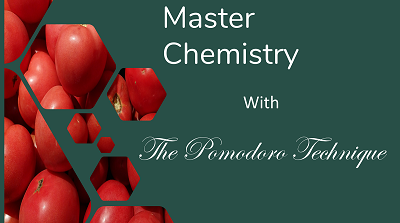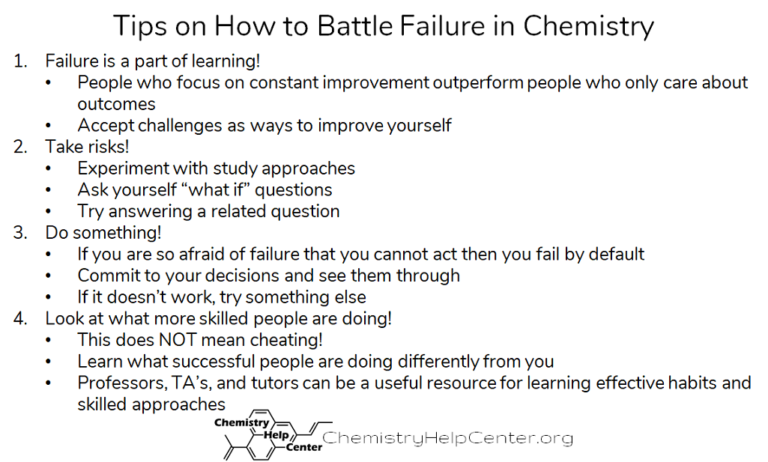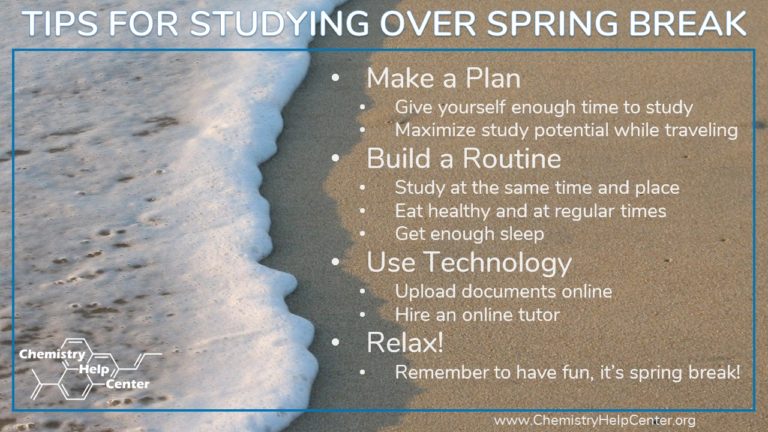The Pomodoro Technique for Chemistry Students
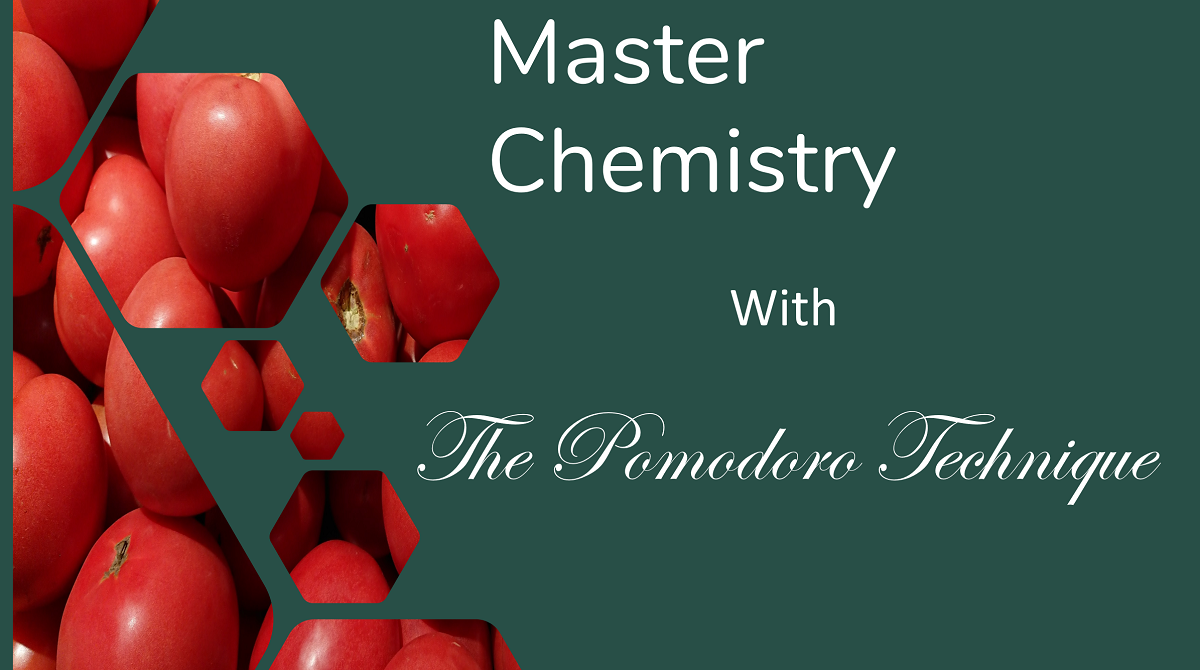
The Pomodoro Technique is an excellent time management tool for chemistry students. It uses a timer to help divide study time into work sessions, called Pomodoro’s 🍅. Each pomodoro consists of 25 minutes of focused study, followed by a 5-minute break. It’s a simple formula, but it really does get results. Most chemistry students don’t have a problem with understanding the material. But the problem is usually is finding the time to study said material and get everything done. Procrastination is also a huge problem that many of use struggle with. Or, perhaps, you spend hours studying, but spend as much time looking at your phone as you do going over the material. If that sounds like you, don’t worry! Everyone behaves like that at least a little. 😊 The pomodoro technique will get you through your coursework and boost your grade in class.
Step by Step
A study session using the Pomodoro technique has four phases.
- A planning phase. ✏
- A few cycles of work. 🔄
- Rest phases. 😎
- And finally, a thoughtful phase 🤔 where you record your results 📝 and think about how you can improve 💪 next time.
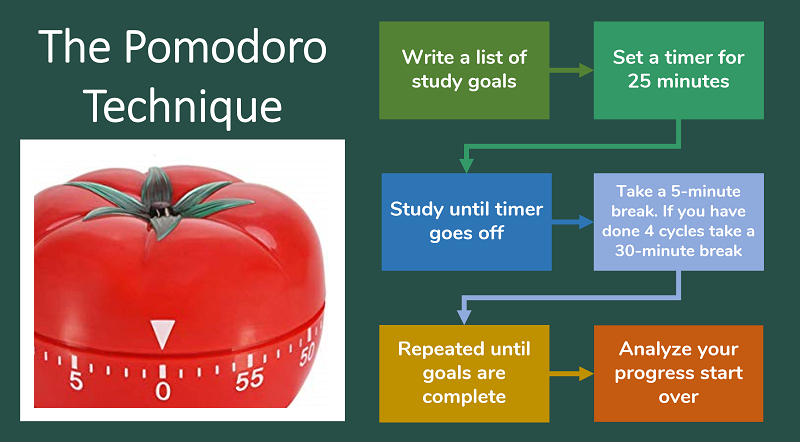
Make a Plan
Before you start your study session think about the best way to use your time. Pick a time where you have between 2-4 hours to study without interruption. Then, make a list of all the things that you want to accomplish. The final touch is to arrange everything in terms of Pomodoro’s. So an example might look like:
- Study at the library between 2:00p and 5:30p.
- Pomodoro 1: questions 1-3
- Pomodoro 2: questions 4-6
- Pomodoro 3:questions 7-9
- Pomodoro 4: questions 9-12
- 30 min break
- Pomodoro 5: read section one for class tomorrow
- Pomodoro 6: review/organize notes
Get to work
Now that you have planned out your study session it’s time to get started! Set your timer for 25 min and dive into your first Pomodoro. While you are working, focus on attacking your project with as much energy as you can muster. Push away any sort of interruption or distraction until after the timer goes off 📴.
Avoiding distractions can be a lot more difficult than it sounds. 😰 It takes practice to be able to work on one subject continuously. Markdown 📝 every time you are interrupted, or that you feel the urge to do anything except to study. That will be useful data in the future to help you learn to avoid your personal distractions and to keep track 💯 of your progress. If you finish before the timer ⏰ goes off, keep working! Go back 🔙 and review or get a jump start on your next pomodoro.
Take a break
After working for 25 minutes, you have earned a break! Give yourself 5 minutes to stretch your legs 🚶♀️, go to the bathroom 🚽, or check your phone 📱 for anything that needs your quick response. Whatever you need to do to relax and clear your mind before starting the next Pomodoro. It is much easier to resist distractions when you are studying if you know that there is a break coming up in just a few minutes. When you have completed 4 Pomodoro’s in a row, give yourself a longer 15-30 minute break. After a longer break switch up 🔃 what you are studying. This will help to keep you from exhausting yourself and lose focus.
Track and adjust
After you do a few Pomodoro’s you will end up with a lot of data on yourself. Things like time spent studying, number and type of distractions, and problem areas, are all useful metrics for you to track. If you like journaling, then this is the perfect thing to make a big weekly splash page about! Otherwise, a simple page tucked in with your chemistry notes will work just as well. Use this information to improve your study habits. Maybe a particular distraction keeps coming up. Or maybe there is a time of day where you always get better results. Look at your study habits and what is working for you, and what you can improve on. Seeing these improvements week to week will feel great 😁 and help you to stay on track! 💯💪

Part two: When to use it
The Pomodoro 🍅 technique is powerful 💪 tool ⚒ for chemistry students who are struggling 😰 to keep up with the class. But just like any tool, you need to know 💡 what it is good for and how to use it.
Pomodoro technique makes a few assumptions about the way that you are going to be studying. For the most part all these assumptions are going to be true. 👍 But if they aren’t 🤷♂️ for whatever reason you can always modify the technique to suit your personal style better. 😉
Assumption # 1: all distractions are bad.
The technique has a very specific idea of what studying should look like. Anything that interrupts your work, or is not directly related to the task you are doing is bad. This encourages you to study alone instead of a group environment. For the most part, this is actually a great way to study chemistry. In fact, we have an entire blog post about how to set up a quiet and productive study space.
Chemistry classes take a lot of mental energy. You probably are going to need to spend most of your study time ⌛ quietly 🤫 working alone as you try to get a better grasp on challenging concepts. That said, there are advantages to working in groups 👩⚕️👨🎓👩🌾👨💼 too. If you feel like you might benefit from a fresh perspective, a sudden bust of creativity, or a feedback from one of your peers, then you might want to consider bouncing a few ideas off a friend.
Assumption # 2: The biggest challenge students face is time management
Many students struggle to manage studying 10-15 hours a week, going to class, and keeping up with lab. The pomodoro technique is very effective for these students because it helps break large projects into smaller, more manageable pieces. The timer helps with focus. Frequent breaks help to make the process seem less overwhelming. And so on. If chemistry makes you feel overwhelmed 😱 or you struggle to keep up with the class then you should try the pomodoro.🍅 technique.
Assumption #3: You have lots of time to study
In my opinion, this is one of the biggest weaknesses of the pomodoro technique. Going for full set of Pomodoro’s will take a solid two hours. The reality is that chemistry is a hard class, and you are going to have to spend a lot of time studying no matter what. So, it’s a good idea to block out one or two long study sessions every week. On the other hand, sometimes life gets in the way and you must sneak in study time where you can find it. If you have 15 minutes to study don’t give up and do nothing just because you don’t have enough time to do a pomodoro! Some study time is always better than no study time so do your best to get it in whenever you can.
Specific examples
Let’s look at a few example where the pomodoro 🍅 technique shines 🌟 the most. This list isn’t going to cover everything but hopefully, it can help give you some idea how to apply the technique to your personal study habit.
Example One: Reading the book
Reading the section of the textbook chapter for the topic you’re covering in class before you go to class is the one thing that will instantly boost your grade. Read our blog post on how to prepare for lecture to find out why. Of course, I understand why some might not read the textbook. It’s boring, it’s time consuming, it’s easy to just put off and forget about. Some instructors never formally assign the reading, so you have to figure out yourself what to read.
The pomodoro technique can help in a lot of ways with this. You will be working by yourself and will benefit from removing distractions. Planning a specific time to read the textbook will help you to stay committed, and get it done before your next lecture. Reading in 25-minute chunks will make the task feel a lot less daunting to get started and will keep you from burning out and becoming a “book zombie”. Quiet reading is pretty much the perfect time to use this technique.
Example Two: Practice Problems
Solving chemistry problems is a practical skill and you can only get better by doing it. Just going to lecture and reading the textbook aren’t going to be enough to ace your chemistry class. Most of the time you spend studying chemistry should be spent doing practice problems. If your teacher assigns them that’s great, if not, find some questions out of your book or online. 💻 The pomodoro technique works here for a lot of the same reasons that it works for reading the book. You are going to be spending a lot of time on it, and it’s good to schedule it out and break it up into smaller chunks. The difference is if you are having trouble with a problem or concept you can really benefit from talking it through with someone else or setting the problem down for a little bit. The solution might come while you are thinking about something else! A good middle ground is scheduling Pomodoro’s for practice problems but keep track of problems that you are having trouble with and bring those examples to your study group, your professor after class, or your tutor. If you don’t have a study group we have a blog on how to get one started.
Final Thoughts
Chemistry has a reputation as a difficult class. Many students are afraid to take it or call it a weeder class. The truth is that you really don’t have anything to be afraid of. The most difficult part of taking a chemistry class isn’t the content but learning to keep up with amount of coursework you are expected to do. Stick with the pomodoro technique and you will finish quicker so can get good grades and still have a social life! When you are getting started, remember to be patient with yourself. Old habits aren’t going to change overnight. Everybody makes mistakes, but don’t let them hold you back. If you can’t make it through a pomodoro, or don’t finish everything you wanted to get done shake it off and start over again the next day. If you practice and don’t give up you will be getting your work done in half the time! You can do it, just don’t give up.

